2. 中国地质科学院矿产资源研究所,自然资源部成矿作用与资源评价重点实验室,北京 100037
2. MNR Key Laboratory of Metallogeny and Mineral Assessment, Institute of Mineral Resources, CAGS, Beijing 100037, China
作为板块构造运动最重要的表现形式之一,大洋俯冲是研究古大洋演变和古老造山带形成的关键(Stern, 2002)。通常来说,大洋俯冲事件导致在俯冲带之上的活动大陆边缘形成由安山岩-英安岩-流纹岩系列和少量玄武岩等弧火山岩组成的大陆弧岩浆作用(郑永飞等, 2015)。而且大洋俯冲事件通常会经历长期的演变过程,从俯冲伊始到最终大洋的闭合,俯冲板片会经历初始俯冲、俯冲板片折返和断离、俯冲角度的变化等过程,与之响应的岩浆事件也会发生复杂的改变(DeCelles et al., 2009)。板片俯冲过程中发生脱水作用形成一系列弧岩浆作用(Syracuse and Abers, 2006),加之岩浆弧在后期的地质作用中容易保留下来,因此其时空分布特点可以指示并复原俯冲过程中的运动学和动力学特征(李世民, 2018)。而对弧岩浆的类型等的判别可以指示其来源于俯冲沉积物(如Tatsumi, 2006)或俯冲洋壳(Defant and Drummond, 1990)等不同的源区特征。因此弧岩浆岩的研究对于还原俯冲带演化过程有着重要的意义。
班公湖-怒江缝合带(BNSZ,以下简称班-怒带)分布于青藏高原中部(图 1a),代表班公湖-怒江特提斯洋(以下简称班-怒洋)的残余遗迹(Yin and Harrison, 2000)。班-怒带西段一系列与中酸性岩浆岩组合有关的斑岩-浅成低温热液型铜多金属矿床的发现,例如形成于班-怒洋北向俯冲背景下的多龙矿集区等(唐菊兴等, 2016, 2017; Lin et al., 2019; Song et al., 2018),使得班-怒带成为近年来的研究热点。前人对于班-怒洋的演化研究已经进行了数十年,以沉积地层及古生物、岛弧火山岩、洋岛玄武岩、蛇绿混杂岩等研究对象开展了详细的讨论(Kapp et al., 2007; Shi et al., 2008; Yang et al., 2009; Li et al., 2009; Pan et al., 2012; Zhu et al., 2013; Geng et al., 2016; 许志琴等, 2016),但许多问题仍悬而未决。例如,学者们对于班-怒洋的开合时间、俯冲极性等有着不同的看法,认为班-怒洋初始裂解于石炭纪时期(Zhu et al., 2013)或二叠纪至早侏罗世、早白垩纪世(Wang et al., 2016; Fan et al., 2018; Li et al., 2019b)。班-怒洋的最终闭合可能发生于中-晚侏罗世(Ma et al., 2017; Li et al., 2017a, 2019b)到晚白垩世(Kapp et al., 2007; Zhang et al., 2012; Sui et al., 2013; Fan et al., 2018)。传统观点认为班-怒洋的俯冲极性以北向俯冲为主(Yin and Harrison, 2000; Guynn et al., 2006; Liu et al., 2017; 唐菊兴等, 2016; Zhang et al., 2017; Lin et al., 2019; 宋扬等, 2019),而近年来越来越多的学者们提出班-怒洋存在双向(向南、向北)的俯冲模式(Zhu et al., 2013, 2016; Li et al., 2018; Ma et al., 2020)。以上争议势必造成了班-怒带两侧晚侏罗世-早白垩世岩浆作用成因机制的多解性,众多学者认为研究区北侧(图 1)发育的晚侏罗世-早白垩世岩浆作用属于班-怒洋向北俯冲的产物(Kapp et al., 2003; 唐菊兴等2016; Li et al., 2013, 2016; Ding et al., 2017; Lin et al., 2017a, b),其中多龙矿集区的成矿构造动力学背景亦存在着正常俯冲(Li et al., 2013)和俯冲板片折返(林彬等, 2019)两种模式。而位于多龙矿集区南侧改则县地区的闪长玢岩成岩时的俯冲阶段和深部动力学过程仍缺乏详细的刻画,这对该地区成矿作用的约束非常重要。本文对班-怒带西段北缘改则县地区上侏罗-下白垩统沙木罗组地层中的闪长玢岩开展了地质年代学、元素和同位素地球化学等方面的研究,对其岩石成因、构造地质背景及深部地球动力学过程等进行了探讨,旨在为班-怒洋北向俯冲深部过程与成矿作用的关系进行详细刻画,并为班-怒洋的演化提供新的证据。
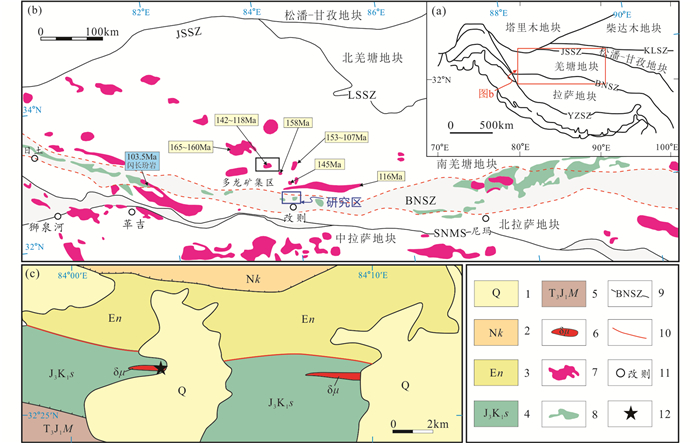
|
图 1 研究区大地构造位置及地质简图 (a)青藏高原大地构造格架(据宋扬等, 2014; 唐菊兴等, 2017修改; 年龄数据源自雷传扬等, 2018; 刘文等, 2019及其中参考文献);(b)藏西北大地构造格架及岩浆岩分布地质简图(据刘文等, 2019修改);(c)研究区地质简图(底图据Huang et al., 2017修改). YZSZ-雅鲁藏布江结合带;BNSZ-班公湖-怒江结合带;JSSZ-金沙江结合带;KLSZ-昆仑结合带;LSSZ-龙木措-双湖结合带;SNMS-狮泉河-纳木错混杂岩带. 1-第四系;2-新近系康托组;3-古近系纳丁错组;4-上侏罗统-下白垩统沙木罗组;5-上三叠-下侏罗统木嘎岗日岩群;6-闪长玢岩;7-藏西北岩浆分布;8-藏西北沙木罗组分布;9-主缝合带;10-断层;11-地名;12-采样点 Fig. 1 Sketch tectonic map and geological map of the study area (a) sketch tectonic map of the Tibetan Plateau (after Song et al., 2014; Tang et al., 2017. Data of ages from Liu et al., 2019 and therein references); (b) sketch tectonic map of the North Tibet and the distribution of magmatic rocks (after Liu et al., 2019); (c) sketch geological map of study area (modified after Huang et al., 2017). YZSZ-Yarlung Zangbo Suture Zone; BNSZ-Bangongco-Nujiang Suture Zone; JSSZ-Jinsha Suture Zone; KLSZ-Kunlun Suture Zone; LSSZ-Longmu Co-Shuanghu Suture zone; SNMZ-Shiquan River-Namu Co Suture zone. 1-Quaternary; 2-Neogene Kangtuo Fm.; 3-Paleogene Nadingcuo Fm.; 4-Upper Jurassic to Lower Cretaceous Shamuluo Fm.; 5-Upper Triassic to Lower Jurassic Mugagangri Group; 6-diorite porphyrites; 7-the distribution of magmatism in Northwest Tibet; 8-the distribution of Shamuluo Fm. in Northwest Tibet; 9-main suture zone; 10-faults; 11-county; 12-locations of samples |
班-怒带作为西藏三大板块缝合带之一(图 1a),同样也是西藏四大成矿带之一(其余为冈底斯、北喜马拉雅和三江成矿带)(唐菊兴等, 2019),属于南侧拉萨地体和北侧羌塘地体的分界线。班-怒带西端以班公湖为起点,向东经改则、丁青和嘉玉桥等到八宿,东西跨度大于2000km,以改则和丁青县为界分为西、中、东段(强巴扎西等, 2016)。该缝合带主要由侏罗纪的蛇绿岩和中生代的木嘎岗日群复理石沉积建造组成,其中蛇绿岩主要表现出与俯冲有关的SSZ型(Shi et al., 2008; Wang et al., 2016),木嘎岗日群主要发育有半深海-深海环境沉积的砂岩、页岩以及少量的玄武岩(Fan et al., 2015; Zeng et al., 2016)。带内另发育晚侏罗-早白垩世的岩浆岩及沉积地层等。
研究区位于班-怒带内西段改则县西北约20km,大地构造位于羌塘地体南缘和拉萨地体北缘(图 1)。区内发育地层主要包括上三叠统-下侏罗统木嘎岗日岩群(Τ3J1M)、上侏罗统-下白垩统沙木罗组(J3K1s)、古近系纳丁错组(En)、新近系康托组(Nk)以及第四系沉积物和残坡积物(Q)等(图 1c)。木嘎岗日岩群主要是一套复理石建造,岩性主要包括粉砂质板岩和变质长石石英砂岩;沙木罗组主要含有一套弱变形的碎屑岩,含灰岩夹层,不整合覆盖于木嘎岗日岩群和蛇绿岩之上;纳丁错组为一套火山岩建造,岩性主要包括玄武岩、火山角砾岩、凝灰岩等,以断层方式逆冲推覆于南侧沙木罗地层之上(图 1c);康托组岩性主要为一套砂岩、砾岩,角度不整合覆盖于纳丁错组之上。研究区中酸性侵入岩发育较少,但研究区北侧以及多龙矿集区区域发育大量中生代岩浆活动(图 1b)。区内NWW向断裂发育,为一系列北倾的逆冲断层,是班-怒洋盆北向俯冲留下的构造痕迹。
本次研究的闪长玢岩呈岩脉侵位于沙木罗组碎屑岩中,近东西走向,出露面积较小,与围岩有着明显的接触界线,野外观察无显著的烘烤边或冷凝边结构(图 2a, b)。本文研究采集了新鲜的样品,手标本样品未发现明显的蚀变和风化现象,亦无脉体发育,呈灰黑色,斑状结构,块状构造,基质为显微晶质结构(图 2c, d)。斑晶含量约占10%,杂乱分布,局部矿物发育一定程度的定向性,主要由角闪石(±8%)和斜长石(±2%)组成,其中角闪石可见发育明显的两阶段,早期呈深绿色,被后期淡绿色角闪石所穿切(图 2e),发育暗化边,呈自形程度较高的长柱状或六边形状,粒径大小不均,最小0.2mm,最大可达5mm以上,部分角闪石发生局部绿泥石化蚀变;斜长石多为椭圆状,表面较脏,部分可见环带发育,少数矿物发育方解石化和泥化蚀变。其中基质占比约90%,以斜长石为主,发育较少的石英矿物和角闪石微晶,并发育以锆石和磷灰石为主的副矿物,可见磷灰石以嵌晶结构发育于角闪石中。岩体边缘相发育围岩捕虏体,肉眼观察无明显反应边,而镜下可观察到捕虏体边缘发育薄层的暗色烘烤边,捕虏体由斜长石、石英等岩屑组成,多发生绿泥石、泥质等蚀变(图 2f)。
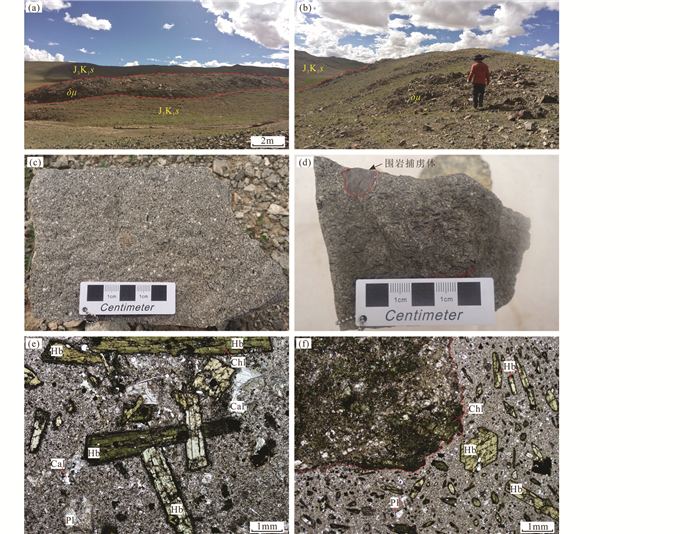
|
图 2 西藏改则地区闪长玢岩野外(a、b)、手标本(c、d)及镜下(e、f)照片 Hb-角闪石;Chl-绿泥石;Cal-方解石;Pl-斜长石 Fig. 2 The field (a, b), hand specimen (c, d) and microscope (e, f) photos of diorite porphyrite in Gaize area, Tibet Hb-hornblende; Chl-chlorite; Cal-calcite; Pl-plagioclase |
用于锆石测年的样品(18GZD04)采自地表闪长玢岩露头新鲜样品,采样位置如图 1c所示。锆石单矿物分选及CL拍照在广州拓岩检测技术有限公司完成,将破碎至80~120目的样品粉末进行淘洗,以去除较轻的矿物,最后利用磁选和浮选两种方法分选出锆石矿物颗粒,挑选晶形和色泽较好、通透程度高的锆石颗粒进行环氧树脂制靶,用阴极发光(CL)显微镜照相观察其内部结构并拍照,选点测试时避开内部矿物包裹体、裂痕进行圈点。锆石激光剥蚀等离子体质谱(LA-ICP-MS)U-Pb同位素测年实验在中国地质科学院矿产资源所自然资源部成矿作用与资源评价重点实验室完成。使用RESOlution S-155激光剥蚀系统对矿物进行剥蚀,利用BRUKER auroa M90电感耦合等离子体质谱仪对剥蚀出的成分开展测试,载气为氦气,补充气体为氩气,在进入ICP-MS之前与氮气混合于T形连接器。使用直径为30μm的激光束斑进行剥蚀,频率为10Hz,测试之前进行0.5s的预剥蚀清洁锆石表面,每次分析采集约20s的背景值后再采集40s作为数据值。锆石年龄计算时的外标为国际标准锆石GJ-1和91500。用ICP-MS-DataCal程序计算测试结果(Liu et al., 2010),未进行铅校正,利用Excel中的Isoplot程序完成平均年龄计算及谐和图绘制(Ludwig, 2003)。详细的分析步骤和数据处理过程可参考文献(侯可军和袁顺达, 2010)。
2.2 全岩主微量元素样品采集位置与锆石U-Pb测年位置相同,样品新鲜,无蚀变和风化作用影响。在广州拓岩检测技术有限公司完成样品200目碎样工作,在核工业北京地质研究院分析测试中心完成全岩主微量元素测试。参照GB/T14506.28-93硅酸盐岩石化学分析方法X射线荧光光谱法,在飞利浦PW2404X射线荧光光谱仪上完成了主量元素的测试分析。采用DZ/T0223-2001电感耦合等离子体质谱方法在Finnigan MAT ELEMENT型高分辨率等离子体质谱仪(ICP-MS)上测定微量元素和稀土元素,大致过程为:每个样品称取50mg样品粉末置于PTFE溶样器皿中,分别加入1mL浓度38%的HF和0.5mL浓度68%的HNO3,蒸干溶液以除掉大部分的硅。再次加入与第一次浓度一致的1mL的HF和0.5mL的HNO3,放置在190℃烘箱中加热12小时。冷却后加入1mL浓度为0.5μg/mL的Rh内标溶液,加热至约150℃蒸干溶液,并再重复两次以上冷却步骤。用8mL HNO3(浓度40%)提取最终的残留物,重新密封溶样器,将其放入110℃烘箱中加热3h冷却之后,加入去离子水将溶液稀释至100mL。
2.3 全岩Sr-Nd-Pb同位素全岩Sr-Nd-Pb同位素测试分析在核工业北京地质研究院分析测试研究中心完成,采用ISOPROBE-T热电离质谱仪开展测试,其中Rb-Sr条件为单带,M+,质量分馏用86Sr/88Sr=0.1194校正,标准测量结果为:NBS987=0.710250±7,实验室流程本底:Rb=2×10-10g,Sr=2×10-10g;Sm-Nd条件为三带,M+,质量分馏用146Nd/144Nd=0.7129校正,标准测量结果为:JMC 143Nd/144Nd=0.512109±3。全流程本底Sm、Nd < 50pg;Pb同位素测定用磷酸硅胶将样品置于铼带上,用静态接收方式测量Pb同位素比值。NBS981未校正结果:208Pb/206Pb=2.164940±15,207Pb/206Pb=0.914338±7,204Pb/206Pb=0.0591107±2,全流程本底Pb < 100pg。
3 测试结果 3.1 锆石U-Pb年龄及微量元素本次工作对闪长玢岩样品中晶型完好、环带清晰的50颗锆石进行了锆石U-Pb测年,结果如表 1和图 3所示。CL图像显示,锆石呈灰黑色,少数呈灰白色;大部分发育震荡环带结构,较少发育扇形结构,极少数发育有变质边结构(图 3)。锆石形态可分为两类:第一类呈柱状的自形晶形态,粒径50~150μm,长宽比3:1~2:1;第二类为磨圆较好,呈次圆状-圆状发育,长宽比2:1~1:1,粒径为50~100μm。锆石的Th/U=0.01~2.81,均值0.71,远大于0.1,绝大部分具有岩浆成因锆石特征(吴元保和郑永飞, 2004)。
|
|
表 1 西藏改则地区闪长玢岩(样品18GZD04)锆石U-Pb年龄测年结果 Table 1 Results of zircon U-Pb dating from diorite porphyrites (Sample 18GZD04) in Gaize area, Tibet |
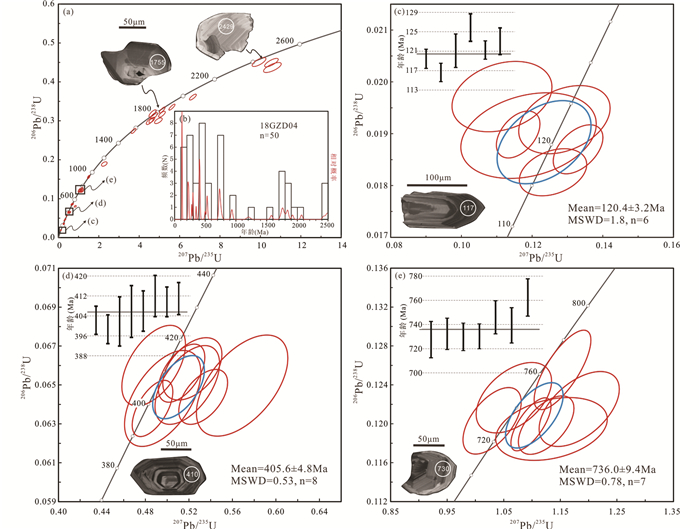
|
图 3 西藏改则地区闪长玢岩锆石U-Pb年龄谐和图(a)和年龄频率分布直方图(b)及117~126Ma段(c)、399~412Ma段(d)、728~762Ma段(e)年龄谐和图及加权平均年龄图 Fig. 3 The concordia plots (a) and the frequency distribution histogram (b) of all zircons with the concordia plots and weight mean ages of stages of 117~126Ma (c), 399~412Ma (d) and 728~762Ma (e) of zircons from diorite porphyrites in Gaize area, Tibet |
所有测试锆石年龄均未明显偏离谐和线(图 3a),表明了有效的锆石测年结果。放射成因的207Pb在年轻锆石积累较少,因此当锆石测试计算年龄 < 1000Ma时选用206Pb/238U年龄作为其结晶年龄,当>1000Ma时选用207Pb/235U年龄。测试结果显示,闪长玢岩锆石U-Pb年龄介于117~2488Ma之间,集中分布于5个年龄段(图 3b),分别为(1):117~126Ma阶段(占比12%),表现出明显的峰值120Ma,该阶段显示出较为谐和的年龄,加权平均年龄为120.4±3.2Ma(图 3c);(2):214~302Ma阶段,该阶段无明显的峰值;(3):399~412Ma阶段(占比16%),峰值为406Ma,亦发育较为谐和的年龄,加权平均年龄为405.6±4.8Ma(图 3d);(4):728~762Ma阶段(占比14%,峰值736Ma),年龄较谐和,加权平均年龄为736±9.4Ma(图 3e);(5):1736~2488Ma阶段无峰值。最新锆石年龄为117Ma,因此将闪长斑岩成岩年龄限制在早白垩世中期。
在进行锆石U-Pb测年的同时开展了锆石原位微量元素测试实验,分析结果如表 2所示,整体上锆石稀土元素总含量变化范围较大,介于138×10-6~1972×10-6之间,平均值为672×10-6,∑LREE介于0.33×10-6~119.1×10-6之间,∑HREE变化范围为132.2×10-6~1965×10-6。锆石的球粒陨石标准化稀土元素配分模式表现出明显的岩浆锆石特征(图 4),即强烈的左倾趋势,显著富集重稀土和亏损轻稀土,且轻重稀土元素分馏明显,并具有明显的Ce正异常和不同程度的Eu负异常。各个年龄阶段锆石稀土元素特征较均一,但相互间表现出一定的差异,尤其闪长玢岩结晶阶段(图 4a)锆石的稀土配分模式图与其他较老年龄的锆石(图 4a-c)相比表现出明显的差异,即相对于其他年龄段(Eu/Eu*=0.02~0.71,平均值0.27),117~126Ma年龄段(点序号19、23、42、44、47、48)的锆石Eu元素负异常程度较弱(Eu/Eu*=0.68~0.89,平均值0.78)。原始测试数据利用Geo-fO2_V0.2软件计算(Li et al., 2019a),其中Zr元素未测试,取固定值49600×10-6(Li et al., 2019a),原岩数据取7件闪长玢岩样品全岩地球化学数据的平均值。结果显示,锆石微量元素Ti地质温度介于638~908℃之间(均值767℃),其中岩体结晶年龄段(117~126Ma)锆石Ti地质温度介于761~844℃之间(均值810℃)。Eu/Eu*值介于0.01~1.01之间,117~126Ma年龄段的Eu/Eu*=0.77~1.01;Ce/Ce*值介于1~1463之间,117~126Ma年龄段的Ce/Ce*=32.7~192.7。
|
|
表 2 西藏改则地区闪长玢岩锆石稀土元素和微量元素组成(×10-6) Table 2 The trace elements (×10-6) composition of zircons from diorite porphyrites in Gaize area, Tibet |
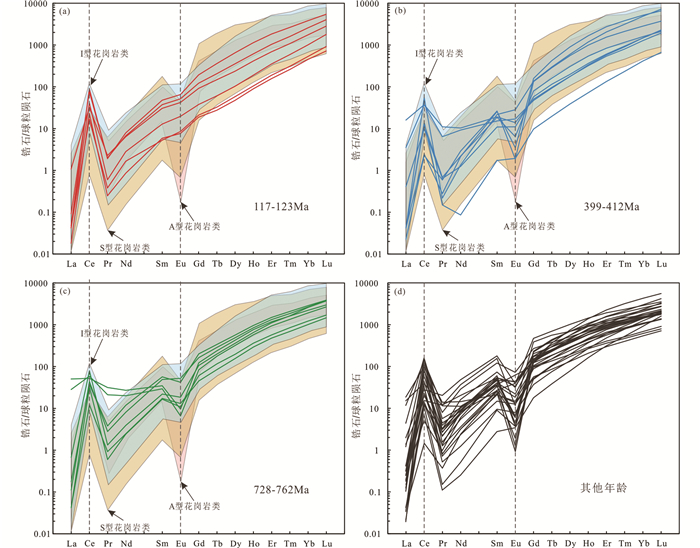
|
图 4 西藏改则地区闪长玢岩锆石的球粒陨石标准化稀土元素配分模式图(标准化值据Sun and McDonough, 1989;I、S、A型花岗岩范围据赵志丹等, 2018) Fig. 4 Chondrite-normalized REEs patterns of zircons from diorite porphyrites in Gaize area, Tibet (normalized values from Sun and McDonough, 1989; the distributions of I-, S-, A-type granites are based on Zhao et al., 2018) |
全岩主微量元素测试分析结果见表 3。改则地区闪长玢岩SiO2含量为58.35%~59.40%(平均值为58.79%),显示中性岩类特征,以及较高的Al2O3(16.39%~16.67%)、全碱(Na2O+K2O=5.79%~8.12%)、FeOT(6.00%~6.41%)和CaO(4.40%~6.12%),较低的MgO(2.15%~2.53%)和P2O5含量(0.31~0.32)。其K2O/Na2O < 1(0.66~0.91),呈富钠贫钾特征。Mg#介于0.39~0.41之间,均值0.40。A/CNK < 1(0.86~0.90),属于准铝质系列。(Na2O+K2O)-SiO2及K2O-SiO2图解(图 5a, b)显示闪长玢岩样品落入闪长岩-二长岩区域,表现出高钾钙碱性特征。
|
|
表 3 西藏改则地区闪长玢岩全岩主量(wt%)、微量(×10-6)分析结果 Table 3 Results of whole-rock major (wt%) and trace (×10-6) elements from diorite porphyrites in Gaize area, Tibet |
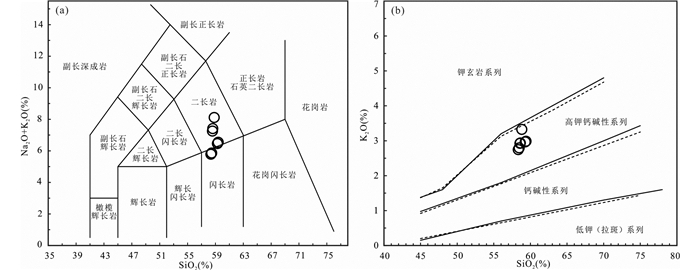
|
图 5 西藏改则地区闪长玢岩(Na2O+K2O)-SiO2 (a)和K2O-SiO2 (b)图解(底图据Middlemost, 1994) Fig. 5 The diagrams of (Na2O+K2O) vs. SiO2 (a) and K2O vs. SiO2 (b) of diorite porphyrites in Gaize area, Tibet (base maps after Middlemost, 1994) |
稀土元素分布特征较为均一(图 6),稀土元素总含量介于189.5×10-6~202.2×10-6之间,平均值为195.4×10-6。LREE/HREE=8.30~9.04(均值8.82),(La/Yb)N介于9.20~10.62(均值9.99),轻重稀土分馏现象显著。图 6a显示其属于富集轻稀土、亏损重稀土的右倾型稀土配分模式,重稀土趋势较为平坦,Eu负异常不明显或较弱(δEu=0.80~0.95)。微量元素蛛网图显示(图 6b),闪长玢岩富集大离子亲石元素Ba、Sr以及高场强元素Th、U、Ce、Zr等,亏损Rb、K、Pb、Nb、Ta、P、Ti等。
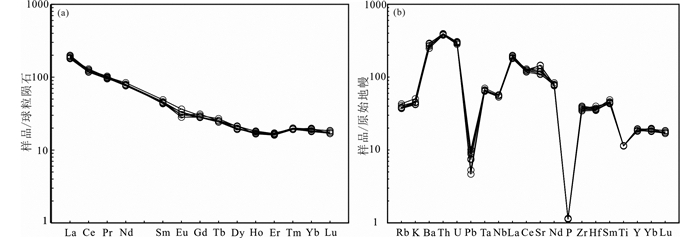
|
图 6 西藏改则地区闪长玢岩球粒陨石标准化稀土元素配分模式图(a)和原始地幔标准化微量元素蛛网图(b)(标准化值据Sun and McDonough, 1989) Fig. 6 Chondrite-normalized REEs patterns (a) and primitive-normalized trace-elements spider diagrams (b) of the diorite porphyrites in Gaize area, Tibet (normalizing values from Sun and McDonough, 1989) |
全岩Sr-Nd同位素和Pb同位素分析结果分别见表 4和表 5。87Sr/86Sr测试比值介于0.705864~0.706328之间,高于原始地幔现代值(0.7045, Depaolo and Wasserburg, 1979),143Nd/144Nd比值为0.512336~0.512453,低于原始地幔现代值(0.512638, Jacobson and Wasserburg, 1980)。利用前文获得的闪长玢岩最年轻年龄段加权平均年龄120.4Ma计算Sr、Nd同位素初始比值,结果显示,(87Sr/86Sr)i=0.7053~0.7059,(143Nd/144Nd)i=0.51225~0.51236,fSm/Nd值介于-0.45~-0.40之间,Nd同位素二阶段模式年龄tDM2集中于1.1~1.3Ga,εNd(t)=-4.6~-2.4(均值-3.6)。闪长玢岩测试的206Pb/204Pb比值为18.666~18.830,207Pb/204Pb=15.612~15.644,208Pb/204Pb=38.844~39.047。同样的,经加权平均年龄120.4Ma计算后的(206Pb/204Pb)t、(207Pb/204Pb)t、(208Pb/204Pb)t值分别为18.535~18.568、15.605~15.636、38.628~38.744。
|
|
表 4 西藏改则地区闪长玢岩Sr-Nd同位素组成 Table 4 Results of Sr and Nd isotopic compositions of diorite porphyrites in Gaize area, Tibet |
|
|
表 5 西藏改则地区闪长玢岩Pb同位素组成 Table 5 Results of Pb isotopic compositions of diorite porphyrites in Gaize area, Tibet |
本文采集的闪长玢岩呈岩脉出露于上侏罗统-下白垩统沙木罗岩屑长石石英砂岩中,前人对改则地区沙木罗地层中发育的碎屑锆石研究发现,其沉积年龄大于130Ma(Huang et al., 2017; Li et al., 2017b)。而闪长玢岩挑选出的锆石显示出碎屑锆石特征,类型较为复杂(图 3),锆石U-Pb测试结果(图 3a, b)显示出较大的年龄变化范围(117~2488Ma),主要集中于5个阶段,即117~126Ma(峰值120Ma)、214~302Ma(无峰值)、399~412Ma(峰值406Ma)、728~762Ma(峰值736Ma)、1736~2488Ma(无峰值),其中大于200Ma的年龄分布特征与沙木罗组中碎屑锆石年龄分布范围一致,加之岩体边缘相中发育的沙木罗组地层捕虏体现象(图 2),证实了这些捕虏锆石来源于沙木罗地层。而其所在最年轻阶段(117~126Ma)年龄较为谐和,加权平均年龄为120.4Ma±3.4Ma,明显小于改则地区沙木罗组地层最小沉积年龄130Ma(Huang et al., 2017; Li et al., 2017b),因此可以代表闪长玢岩的结晶年龄,即改则地区沙木罗组地层中发育的闪长玢岩形成于早白垩世中期(120.4±3.2Ma),前人首次在该组地层中发现的闪长玢岩成岩于103.5±1.4Ma(雷传扬等, 2018),因此本文报道的闪长玢岩为首次在沙木罗地层中发现的早白垩世中期岩浆活动。
4.2 岩石成因及岩浆源区西藏改则地区沙木罗组发育的闪长玢岩有着较低的A/CNK比值(0.86~0.90)和P2O5含量(0.31%~0.32%),不含有堇青石、白云母等过铝质标型矿物,因此不属于S型花岗岩类别;其1000×Ga/Al=2.19~2.48(均值2.38),小于2.6,因此可以排除A型花岗岩类别;CIPW计算所得分异指数(Differentiation Index)介于59.33~69.31之间(均值63.55),从而排除高分异花岗岩类别。改则地区闪长玢岩含有大量Ⅰ型花岗岩的标志矿物角闪石,测试样品全部落入Ce-SiO2图解中的Ⅰ型花岗岩类别范围内,大部分均落入A/MF-C/MF图解中的基性岩部分熔融区域,与上文提到的前人首次在沙木罗组地层中发现的闪长玢岩(雷传扬等, 2018)属于相同的成因类别(图 7),即均为Ⅰ型花岗质岩石类型。岩浆锆石的球粒陨石标准化稀土元素配分模式图同样佐证了本文闪长玢岩属于Ⅰ型花岗岩质岩石类型(图 3a)。
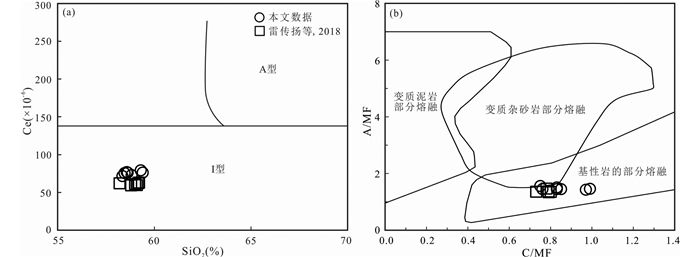
|
图 7 西藏改则地区闪长玢岩Ce-SiO2 (a, 底图据Collins et al., 1982)和A/MF-C/MF (b)图解(底图据Altherr et al., 2000) A/MF=Al2O3/(MgO+FeOT),C/MF=CaO/(MgO+FeOT) Fig. 7 The Ce vs. SiO2 (a, base map after Collins et al., 1982) and A/MF vs. C/MF (b, base map after Altherr et al., 2000) diagrams of the diorite porphyrites in Gaize area, Tibet |
本文闪长玢岩高Y含量(28.4×10-6~30.8×10-6),低La/Yb比值(12.83~14.81),高(87Sr/86Sr)i值(0.7053~0.7059),非常低的Cr(9.70×10-6~20.80×10-6)、Ni(6.05×10-6~8.70×10-6)含量,均与埃达克质岩地球化学特征有明显的差异。Sr/Y-Y图解显示闪长玢岩样品均落入经典岛弧型岩石范围内(图 8),暗示本文闪长玢岩为典型的岛弧型中性岩浆岩,与研究区北部约80km处多龙矿集区中广泛发育的弧岩浆岩类似(唐菊兴等, 2016)。前人对弧环境形成的中酸性岩浆岩开展了大量研究工作,并总结出三类成因机制:(1)俯冲板片的部分熔融(Martin et al., 2005; Defant and Drummond, 1990; Castillo, 2012);(2)幔源玄武质岩浆的分离结晶(Annen and Sparks, 2002; Grove et al., 2003);(3)幔源玄武质岩浆与壳源长英质岩浆的混合,及壳幔混合作用(Richards, 2003; Kemp et al., 2007; Chiaradia et al., 2011)。
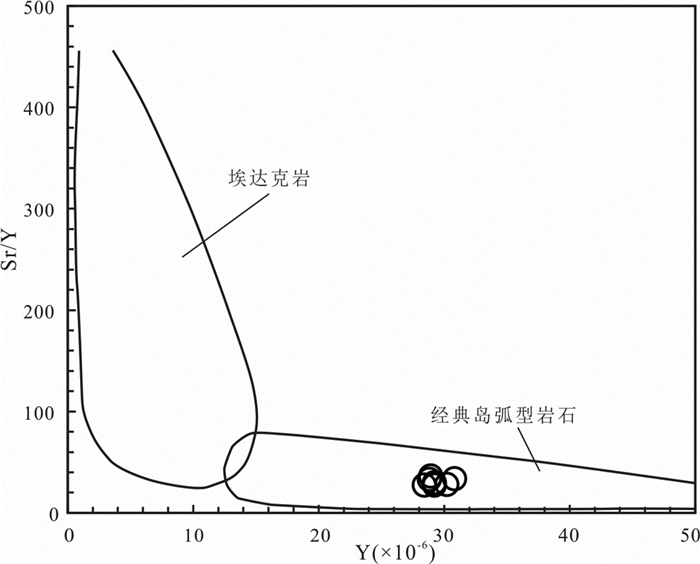
|
图 8 西藏改则地区闪长玢岩Sr/Y-Y图解(底图据Defant and Drummond, 1990) Fig. 8 The Sr/Y vs. Y diagram of diorite porphyrite in Gaize area, Tibet (base map after Defant and Drummond, 1990) |
前人研究认为俯冲板片一般不会发生部分熔融,但在含水的洋壳俯冲过程中可以发生部分熔融,即年轻的大洋岩石圈发生低角度缓慢俯冲时,洋壳物质可以发生饱和水或脱水熔融,基性岩部分熔融形成埃达克岩(张泽明等, 2020)。但目前没有证据表明班-怒洋洋壳于早白垩世发生了低角度的俯冲作用(Zhu et al., 2019),且本文闪长玢岩无埃达克岩特征(图 8),因此排除了俯冲板片部分熔融的成因机制。强亲岩浆元素(如Ta、Th、La、Ce)会在岩浆发生分离结晶作用过程中发生富集,而亲岩浆元素(如Zr、Hf、Sm)的丰度也几乎同步上升(Allègre and Minster, 1978)。因此若发生岩浆的分离结晶作用,强亲岩浆与亲岩浆元素的比值应为常数;而在部分熔融过程中,亲岩浆元素进入熔体的速率要小于强亲岩浆岩元素,因此在岩浆发生部分熔融作用时,强亲岩浆元素/亲岩浆元素应呈逐渐上升趋势。强亲岩浆元素(Th)-亲岩浆元素(Hf)比值关系图(图 9a)显示,本文闪长玢岩成岩过程以部分熔融为主,可能涉及轻微的分离结晶作用。斜长石的分离结晶作用发生在岩浆锆石结晶前和结晶过程可能会导致锆石中Eu元素的负异常(Hoskin and Ireland, 2000),闪长玢岩结晶年龄段(117~126Ma)的锆石δEu(Eu/Eu*)=0.77~1.01(均值0.88),显示轻微或无负异常,表明岩浆结晶过程斜长石的分离结晶作用不明显。加之研究区附近无同时代大规模基性岩浆岩出露,且闪长玢岩稀土配分模式图未出现“四分组”模式效应(图 6a),分异指数(DI)较低(59.33~69.31),综合以上判断,可以排除幔源玄武质岩浆的分离结晶成因机制。利用实验岩石学方法,前人证明了形成于玄武质岩石部分熔融作用的岩浆岩Mg#值往往低于0.4,有地幔组份参与形成的岩浆岩Mg#值则大于0.4(Rapp and Watson, 1995)。本文闪长玢岩Mg#=0.39~0.41(均值0.40),表明玄武质岩浆部分熔融是其主要的成因,源区可能有极少部分地幔组份的加入。加之SiO2与(87Sr/86Sr)i无明显的正比例关系(图 9b),暗示地壳物质的混染作用不明显。Sr-Nd同位素组成特征(图 10a)显示闪长玢岩样品落入古老下地壳、富集地幔和亏损地幔形成的三角区域,与多龙矿集区岩浆岩范围一致。Pb同位素组成显示样品落入EMⅡ与MORB演化线之间(图 10b),并位于EMⅡ范围附近。一般认为,EMⅡ型地幔与俯冲及陆壳再循环的壳幔相互作用有关(Sun and McDonough, 1989; Weaver, 1991),即板片熔体或流体与富集地幔发生了混合作用,表明源区可能为俯冲作用下的新生玄武质下地壳。Th/Ce-Th/Sm图解显示(图 11a),样品均沿俯冲沉积物交代混合曲线分布,表明岩浆源区有少量沉积物熔体组份的参与(< 5%),小于晚期(103.5Ma)侵入于沙木罗组的闪长玢岩沉积物残余比例(6.5%~8%, 雷传扬等, 2018)。而Th/Yb-Sr/Nd图解中(图 11b)显示本文闪长玢岩源区流体主要为板片来源,与晚期闪长玢岩的洋底沉积物来源明显不同(雷传扬等, 2018)。前人研究认为,因Nd可溶解在沉积物熔体中,造成εNd(t)值的降低(Hawkesworth et al., 1993; Pearce and Peate, 1995; Kessel et al., 2005),本文闪长玢岩εNd(t)值介于-4.6~-2.4之间(均值-3.6),证实了源区沉积物熔体的存在。
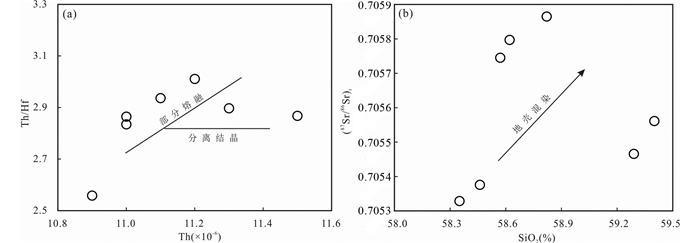
|
图 9 西藏改则地区闪长玢岩Th/Hf-Th (a)和(87Sr/86Sr)i-SiO2 (b)图解 Fig. 9 The diagrams of Th/Hf vs. Th (a) and (87Sr/86Sr)i vs. SiO2 (b) of diorite porphyrites in Gaize area, Tibet |
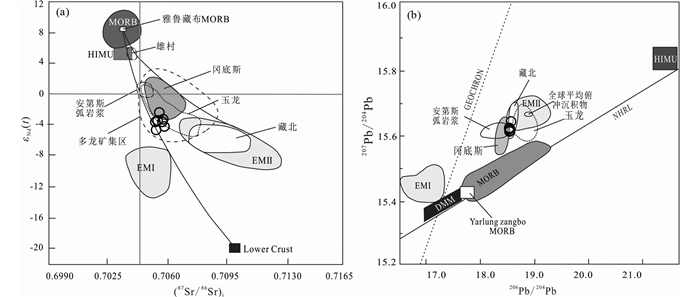
|
图 10 西藏改则地区闪长玢岩Sr-Nd-Pb同位素组成(底图据Lin et al., 2018) DMM-亏损型地幔;HIUH-异常高238U/204Pb型地幔;EMⅠ-富集Ⅰ型地幔;EMⅡ-富集Ⅱ型地幔(引自Zindler and Hart, 1986; Norman and Leeman, 1989).数据来源:雅鲁藏布MORB引自Hou et al., 2004;玉龙引自Jiang et al., 2006;冈底斯、藏北吴伟中等, 2013多龙矿集区数据林彬等, 2019;雄村数据引自Hou et al., 2015;安第斯弧岩浆引自Rabbia et al., 2017;全球平均俯冲沉积物引自Petford and Atherton, 1998 Fig. 10 The Sr-Nd-Pb isotopic compositions of diorite porphyrites in Gaize area, Tibet (base map after Lin et al., 2018) DMM-Depleted MORB Mantle; HIUH-High 238U/204Pb Mantle; EMⅠ-type Ⅰ enriched Mantle; EMⅡ-type Ⅱ enriched Mantle (after Zindler and Hart, 1986; Norman and Leeman, 1989); Data sources: Yarlung Zangbo MORB (Hou et al., 2004); Yulong (Jiang et al., 2006); Gangdese and North Tibet (Wu et al., 2013); Duolong (Lin et al., 2019); Xiongcun (Hou et al., 2015); Andean arc magma (Rabbia et al., 2017); Global Average subduction sediments (Petford and Atherton, 1998) |
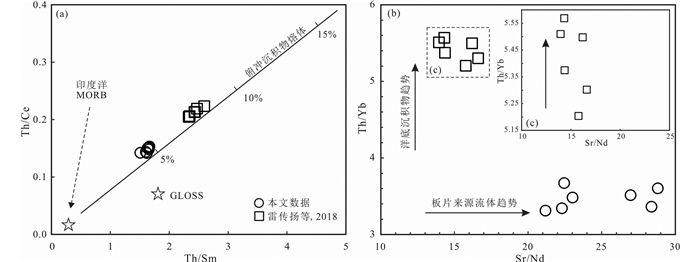
|
图 11 西藏改则地区闪长玢岩Th/Ce-Th/Sm图解(a, 底图据Martin, 1999)和Th/Yb-Sr/Nd图解(b, 底图据Woodhead et al., 1998) Fig. 11 The diagrams of Th/Ce vs. Th/Sm (a, base map after Martin, 1999) and Th/Yb vs. Sr/Nd (b, base map after Woodhead et al., 1998) of diorite porphyrites in Gaize area, Tibet |
源区残留斜长石将会引起中酸性岩浆熔体中Eu元素的负异常(Rollinson, 1993),本文样品δEu值介于0.80~0.95之间(均值0.88),显示轻微负Eu异常(图 6a),表明源区无或残留极少的斜长石等富Eu矿物。研究表明,Nb、Ta元素亏损而Y不亏损可能表明岩浆源区残留较多的石榴子石或角闪石(Pearce and Norry, 1979; 侯增谦等, 2003),本文样品具有Nb、Ta亏损和Y不亏损的特征,表明源区可能残留石榴子石或角闪石。根据HREE在石榴石和角闪石中分配系数的不同可对源区残留相进一步区分,呈现出倾斜的HREE配分模式,Y/Yb比值明显大于10,则残留相以石榴石为主;若具有较平坦的HREE配分模式,且Y/Yb比值接近于10,则以角闪石为主要残留相(Defant and Drummond, 1990; 高永丰等, 2003)。改则地区闪长玢岩有着较为平坦的HREE配分模式(图 6a),且Y/Yb值介于8.55~9.57之间(均值9.14),表明其源区残留相以角闪石为主。综上所述,本文认为改则地区闪长玢岩形成于新生玄武质下地壳的部分熔融,源区残留相以角闪石为主,并有少量沉积物组份的参与(< 5%),岩浆演化过程中分离结晶和地壳混染作用不明显。
4.3 地球动力学背景及意义利用地球化学微量元素判别岩浆岩成岩构造环境时会存在多解性,因此我们运用多种微量元素结合同位素、锆石微量元素判别图解综合对改则地区闪长玢岩的成岩构造环境进行解译。高场强微量元素具有稳定、不活泼的特性,受到后期风化、蚀变等地质作用的影响较小,能够一定程度上反映岩浆源区特征,Th/Yb-Ta/Yb和Th/Yb-Nb/Yb图解(图 12a, b)均显示闪长玢岩属于大陆边缘岛弧构造背景。如上文所述,锆石矿物由于其封闭温度高、稳定性高、抗后期地质作用改造能力强等特性,可以较准确的反映岩浆岩成岩构造背景(赵志丹等, 2018)。前人通过大数据分析处理,在已知构造背景情况下,总结出利用锆石原位微量元素进行判别成岩构造背景的图解(Carley et al., 2014; Grimes et al., 2015),并得到了有效的应用。本文闪长玢岩锆石矿物微量元素U/Yb-Hf和U/Yb-Nb/Yb图解(图 12c, d)显示,所测试样品均落入大陆弧范围内,暗示其大陆岛弧性质。相比全岩主微量元素,全岩Pb同位素性质稳定,受到外界环境影响较小(唐攀等, 2016),Pb同位素判别图解显示所测试样品均落入造山带范围甚至造山带集中区域(图 12e, f),与多龙矿集区Pb同位素分布特征一致,暗示与多龙矿集区有着相同的成岩构造背景,即形成于俯冲造山背景下。综上所诉,本文利用高场强微量元素比值、锆石微量元素比值以及全岩Pb同位素构造环境判别图解综合认为,改则地区闪长玢岩形成于俯冲造山背景下大陆弧环境。
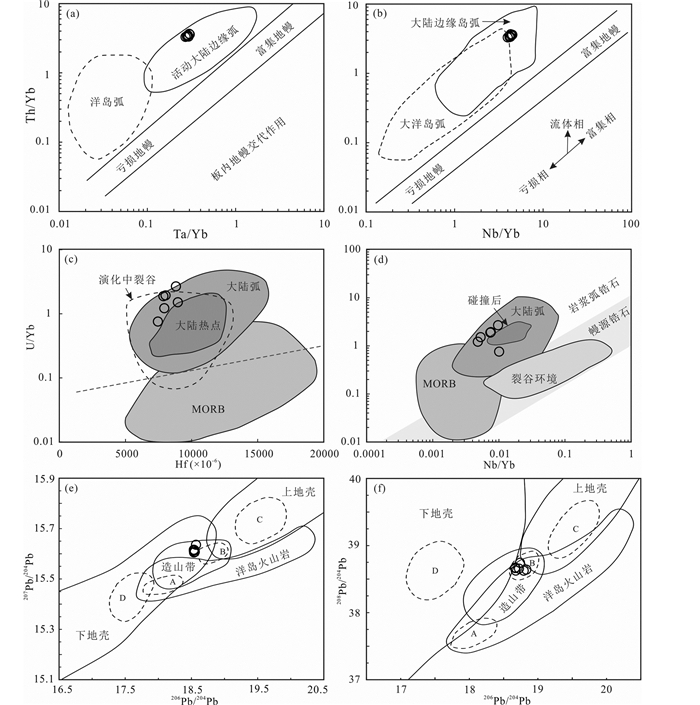
|
图 12 西藏改则地区闪长玢岩成岩构造背景判别图解(a, 据Pearce, 1983;b, 据Pearce and Peate, 1995;c, 据Grimes et al., 2015修改;d, 据Carley et al., 2014修改;e、f,据Zartman and Doe, 1981) (e、f)图中A、B、C、D分别为各区域相对集中区 Fig. 12 Discrimination diagrams for tectonic setting of the diorite porphyrite (the base maps of Fig. 12a-d after Pearce, 1983; Pearce and Peate, 1995; Grimes et al., 2015; Carley et al., 2014, respectively; and (e), (f) after Zartman and Doe, 1981) A, B, C and D are relatively concentrated areas of each region in (e), (f) diagrams |
区域上来讲,本文闪长玢岩侵位于晚侏罗-早白垩世的浅海陆架和碳酸盐岩台地环境中沉积的沙木罗组地层中(图 1b)(Chen et al., 2004; Xie et al., 2010)。Li et al. (2017b)通过对本文研究区沙木罗组的沉积记录、碎屑锆石开展物源分析等研究认为沙木罗组有两种可能的沉积模式:(1)形成于残余海盆,班-怒洋盆的俯冲已经结束,没有明显的地壳缩短但仍存在残余海盆,此时南羌塘地体高于拉萨地体,拉萨地体的碎屑无法越过未填充的前陆盆地,因此沙木罗组沉积物源主要来自羌塘地体;(2)形成于沟槽斜坡盆地,此时班-怒洋仍在北向俯冲,全部来源于南羌塘地体的沉积物不整合覆盖于俯冲杂岩(木嘎岗日岩群)和蛇绿岩之上。研究区北侧多龙斑岩-浅成低温热液型铜多金属矿集区内发育的早白垩世(128~106Ma)火山岩、中酸性侵入岩均形成于大洋板片折返作用下的陆缘弧环境(唐菊兴等, 2016; 林彬等, 2019; Lin et al., 2019),即表明早白垩世班-怒洋仍在北向俯冲。雷传扬等(2018)对革吉县北阿翁错地区沙木罗组地层中首次发现的闪长玢岩开展了地质年代学和元素地球化学研究,提出该岩体形成于班-怒洋北向俯冲于羌塘地体的构造背景下,即103.5Ma时班-怒洋西段仍未完全闭合。综上我们认为在120.4Ma时侵位于改则地区沙木罗组地层中的闪长玢岩成岩于班-怒洋北向俯冲造山背景下的大陆弧环境,由于俯冲板片发生折返引起。侵位于沙木罗组的120.4Ma与103.5Ma闪长玢岩均成岩于相同的构造环境中,但两者深部动力学背景却有所不同:革吉地区沙木罗组地层中侵位的闪长玢岩(103.5Ma)源区物质中的海洋沉积物组份明显多于改则地区闪长玢岩(120.4Ma)(图 11a),暗示着北向俯冲板片角度变大加速了软流圈地幔物质上涌速度,使得更多的俯冲板片上覆沉积物熔融从而导致了源区沉积物组份占比的增加,加之革吉地区闪长玢岩锆饱和温度(759~775℃,均值763℃,数据自雷传扬等,2018)明显高于改则地区闪长玢岩(726~742℃,均值732℃)的现象可证明以上推论,暗示120.4~103.5Ma时,班-怒洋板片俯冲角度继续增大,板片前端折返继续进行(图 13)。
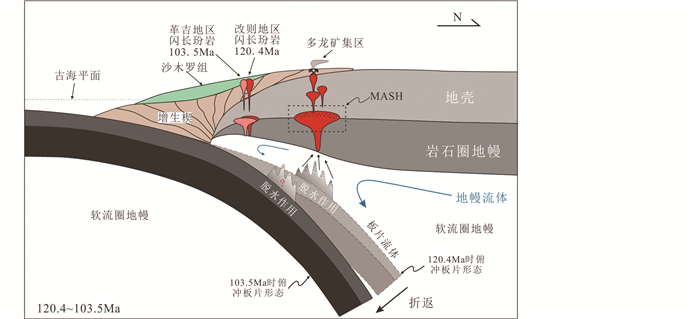
|
图 13 班-怒带西段早白垩世成岩、成矿动力学机制模式图(据林彬等, 2019修改) Fig. 13 Dynamic model in Early Cretaceous of diagenesis and mineralization of the western section of BNSZ (modified after Lin et al., 2019) |
青藏高原发育的多龙矿集区(韦少港等, 2016)、驱龙矿床(Yang et al., 2015)以及朱诺矿床(Sun et al., 2018, 2021)等多个著名的斑岩型铜矿床的形成均与闪长质岩石有所关联,因此闪长质岩石作为一种与成矿密切相关的岩石类型,其含矿性研究有重要的地质意义。研究区北侧多龙矿集区含矿侵入岩与本文闪长玢岩具有同样的成岩时代、构造背景及相似位置的岩浆源区(林彬等, 2019),两者宿命却天差地别,随着铁格隆南这一西藏首例千万吨级斑岩-浅成低温热液型矿床以及拿若等矿床的发现(方向等, 2014; 唐菊兴等, 2016),前者一跃成为世界级斑岩-浅成低温热液型铜多金属矿集区,并被划为全国28个对国民经济具有重要价值的矿区之一(《全国矿产资源规划(2016—2020年)》),而处于缝合带内北缘的改则县附近地区却尚未发现有较大潜力的成矿靶区。
除了成矿围岩条件、成矿后的保存等因素,本文认为改则地区闪长玢岩的时空分布和岩浆源区氧化还原性特征成为其未成矿的众多因素之二:(1)120.4Ma时,多龙矿集区位于俯冲板片前端,随着俯冲作用的进行,俯冲板片前端持续发生脱水作用和部分熔融,较轻的长英质等物质不断析出并以熔体的形式上侵,使得板片前端比重逐渐增大,加之班-怒洋南侧冷的高密度大洋板片发生裂解和断离,由于“跷跷板”原理,导致北侧大洋板片由于重力原因发生下沉和折返,地幔物质加速上涌,板片流体交代上覆地幔发生部分熔融形成玄武质岩浆;基性岩浆继而发生底侵作用至下地壳,发生MASH作用,其形成的中酸性岩浆岩携带金属矿物上侵至增生带中最终形成了多龙矿集区(图 13; 林彬等, 2019)。而位于班-怒带北缘的同时代发育的改则地区闪长玢岩近乎位于俯冲板片后端根部(图 13),其俯冲角度相对较小,板片及上覆沉积物熔融程度较弱,且源区幔源物质加入较少,形成的中酸性岩浆规模较小,因此无法携带巨量金属上侵至浅部并成矿。(2)大量研究表明,含矿岩体常具有较高的Ce4+/Ce3+比值特征,反映了含矿岩浆具有更高的氧逸度,而前人研究证实岩浆携带S的能力与氧逸度呈正相关关系,而岩浆中S的含量直接决定着其是否成矿(Parat et al., 2008; Botcharnikov et al., 2011)。Ce元素在锆石中含有Ce3+、Ce4+两种价态,由于后者半径更接近Zr4+,因此锆石表现为显著的正Ce异常,当熔体/流体更氧化时,Ce以4价为主,会替代更多的Zr4+,因此锆石的Ce4+/Ce3+比值可作为反应锆石结晶时熔体(或流体)氧逸度大小的标志(Trail et al., 2012; Ballard et al., 2002)。尽管存在部分锆石微量元素无法有效识别含矿与贫矿岩体的实例(Sun et al., 2021),但前人对多龙矿集区含矿/不含矿岩体锆石微量元素进行了一系列研究,结果显示多龙矿集区含矿和贫矿岩体的锆石微量有着明显的差别,并且认为多龙矿集区含矿岩体形成于相对较高的氧逸度环境,可将Ce4+/Ce3+>300作为岩体成矿的地球化学标志(李云强等, 2020),与智利北部斑岩型铜矿的含矿岩体的锆石Ce4+/Ce3+比值下限一致(Ce4+/Ce3+>300, Ballard et al., 2002)。而本文研究区临近多龙矿集区且具有相同的构造背景和成岩时代,因此判断该地区闪长玢岩锆石微量元素可能会成为判断含矿性的有效指标,其结晶阶段(117~126Ma)锆石微量元素Ce4+/Ce3+介于30.7~192.7之间(表 2),远低于300,暗示改则地区闪长玢岩源区氧逸度较低,未达到成矿的条件。
如上文所述,班-怒洋壳北向俯冲板片在120.4~103.5Ma时仍在持续发生折返作用,俯冲角度变大,使得形成于103.5Ma的闪长玢岩源区沉积物组份增加。主成矿期约为120Ma的多龙矿集区成矿动力学机制发育位置同样的向南位移(图 13)。因此本文推测改则县地区120Ma至班-怒洋俯冲结束的时间内与俯冲背景有关的成矿事件应发育于多龙矿集区与改则县闪长玢岩发育位置之间。但是否成矿还应考虑如构造、围岩、后期保存等多种条件的影响。
5 结论(1) 改则地区侵位于沙木罗组地层中的闪长玢岩成岩于120.4Ma,为首次于沙木罗组发现该时代的岩浆活动。
(2) 通过元素地球化学、锆石微量元素分布特征等判断本文闪长玢岩属于Ⅰ型花岗岩类,具有明显的岛弧型岩石特征,结合其全岩Sr-Nd-Pb同位素组成特征分析得出其成岩于新生玄武质下地壳的部分熔融,源区以角闪石为主要残留相,并有少量沉积物组份的参与,岩浆演变过程中分离结晶和地壳混染作用不明显。
(3) 改则地区闪长玢岩形成于由班-怒洋北向俯冲板片折返作用引起的大陆弧环境,而相较之下,革吉地区103.5Ma的闪长玢岩源区具有更多的沉积物组份和更高的成岩温度,暗示120.4~103.5Ma阶段班-怒洋板片俯冲角度继续增大,板片前端折返作用继续进行。
(4) 在现有数据分析下,本文认为闪长玢岩未成矿的原因主要有两点:120.4Ma时该岩体成岩于班-怒洋俯冲板片后端根部,俯冲角度相对较小,板片及上覆沉积物熔融程度较弱,且源区幔源物质加入较少,可形成的中酸性岩浆规模较小,因此无法携带巨量金属上侵至浅部并成矿;闪长玢岩源区具有较低的氧逸度,源区无法为成矿提供足够的S。相较于革吉地区闪长玢岩深部动力学成岩背景,我们认为120Ma至俯冲作用结束的时间内与俯冲背景有关的成矿事件应发育于改则地区与多龙矿集区之间,但是否见矿还应考虑构造、围岩、后期保存等条件的影响。
致谢 感谢中铝西藏金龙矿业股份有限公司为笔者的野外工作提供的大力支持;感谢王嘉星、张开江、王超等在野外采样、拍照等过程中的帮助;特别感谢两位审稿专家提出的富有建设性的宝贵意见和期刊编辑老师的修改。
Allègre CJ and Minster JF. 1978. Quantitative models of trace element behavior in magmatic processes. Earth and Planetary Science Letters, 38(1): 1-25 DOI:10.1016/0012-821X(78)90123-1
|
Altherr R, Holl A, Hegner E, Langer C and Kreuzer H. 2000. High-potassium, calc-alkaline Ⅰ-type plutonism in the European Variscides: Northern Vosges (France) and northern Schwarzwald (Germany). Lithos, 50(1-3): 51-73 DOI:10.1016/S0024-4937(99)00052-3
|
Annen C and Sparks RSJ. 2002. Effects of repetitive emplacement of basaltic intrusions on thermal evolution and melt generation in the crust. Earth and Planetary Science Letters, 203(3-4): 937-955 DOI:10.1016/S0012-821X(02)00929-9
|
Ballard JR, Palin MJ and Campbell IH. 2002. Relative oxidation states of magmas inferred from Ce (Ⅳ)/Ce (Ⅲ) in zircon: Application to porphyry copper deposits of northern Chile. Contributions to Mineralogy and Petrology, 144(3): 347-364 DOI:10.1007/s00410-002-0402-5
|
Botcharnikov RE, Linnen RL, Wilke M, Holtz F, Jugo PJ and Berndt J. 2011. High gold concentrations in sulphide-bearing magma under oxidizing conditions. Nature Geoscience, 4(2): 112-115 DOI:10.1038/ngeo1042
|
Carley TL, Miller CF, Wooden JL, Padilla AJ, Schmitt AK, Economos RC, Bindeman IN and Jordan BT. 2014. Iceland is not a magmatic analog for the hadean: Evidence from the zircon record. Earth and Planetary Science Letters, 405: 85-97
|
Castillo PR. 2012. Adakite petrogenesis. Lithos, 134-135: 304-316
|
Chiaradia M, Müntener O and Beate B. 2011. Enriched basaltic andesites from mid-crustal fractional crystallization, recharge, and assimilation (Pilavo Volcano, Western Cordillera of Ecuador). Journal of Petrology, 52(6): 1107-1141 DOI:10.1093/petrology/egr020
|
Chen GR, Liu HF, Jiang GW, Zeng QG, Zhao SR and Zhang XG. 2004. Discovery of the Shamuluo formation in the central segment of the Bangong Co-Nujiang River suture zone, Tibet. Geological Bulletin of China, 23(2): 193-194 (in Chinese with English abstract)
|
Collins WJ, Beams SD, White AJR and Chappell BW. 1982. Nature and origin of A-type granites with particular reference to Southeastern Australia. Contributions to Mineralogy and Petrology, 80(2): 189-200 DOI:10.1007/BF00374895
|
DeCelles PG, Ducea MN, Kapp P and Zandt G. 2009. Cyclicity in Cordilleran orogenic systems. Nature Geoscience, 2(4): 251-257 DOI:10.1038/ngeo469
|
Defant MJ and Drummond MS. 1990. Derivation of some modern arc magmas by melting of young subducted lithosphere. Nature, 347(6294): 662-665 DOI:10.1038/347662a0
|
Depaolo DJ and Wasserburg GJ. 1979. Sm-Nd age of the stillwater complex and the mantle evolution curve for neodymium. Geochimica et Cosmochimica Acta, 43(7): 999-1008 DOI:10.1016/0016-7037(79)90089-9
|
Ding S, Chen YC, Tang JX, Zheng WB, Lin B and Yang C. 2017. Petrogenesis and tectonics of the Naruo porphyry Cu(Au) deposit related intrusion in the Duolong area, Central Tibet. Acta Geologica Sinica, 91(2): 581-601 DOI:10.1111/1755-6724.13119
|
Fan JJ, Li C, Liu YM and Xu JX. 2015. Age and nature of the late Early Cretaceous Zhaga Formation, northern Tibet: Constraints on when the Bangong-Nujiang Neo-Tethys Ocean closed. International Geology Review, 57(3): 342-353 DOI:10.1080/00206814.2015.1006695
|
Fan JJ, Li C, Wang M and Xie CM. 2018. Reconstructing in space and time the closure of the middle and western segments of the Bangong-Nujiang Tethyan ocean in the Tibetan Plateau. International Journal of Earth Sciences, 107(1): 231-249 DOI:10.1007/s00531-017-1487-4
|
Fang X, Tang JX, Li YB, Wang Q, Ding S, Zhang Z, Yang C, Li YB, Chen HQ, Wei LJ and Ni M. 2014. Metallogenic element spatial distribution of the Naruo copper (gold) deposit in the Duolong ore concentration area of Tibet and its geochemical exploration model. Geology in China, 41(3): 936-950 (in Chinese with English abstract)
|
Gao YF, Hou ZQ and Wei RH. 2003. Neogene porphyries from Gangdese: Petrological, geochemical characteristics and geodynamic significances. Acta Petrologica Sinica, 19(3): 418-428 (in Chinese with English abstract)
|
Geng QR, Zhang Z, Peng ZM, Guan JL, Zhu XP and Mao XC. 2016. Jurassic-Cretaceous granitoids and related tectono-metallogenesis in the Zapug-Duobuza arc, western Tibet. Ore Geology Reviews, 77: 163-175 DOI:10.1016/j.oregeorev.2016.02.018
|
Grimes CB, Wooden JL, Cheadle MJ and John BE. 2015. "Fingerprinting" tectono-magmatic provenance using trace elements in igneous zircon. Contributions to Mineralogy and Petrology, 170(5-6): 46 DOI:10.1007/s00410-015-1199-3
|
Grove TL, Elkins-Tanton LT, Parman SW, Chatterjee N, Müntener O and Gaetani GA. 2003. Fractional crystallization and mantle-melting controls on calc-alkaline differentiation trends. Contributions to Mineralogy and Petrology, 145(5): 515-533 DOI:10.1007/s00410-003-0448-z
|
Guynn JH, Kapp P, Pullen A, Heizler M, Gehrels G and Ding L. 2006. Tibetan basement rocks near Amdo reveal "missing" Mesozoic tectonism along the Bangong suture, central Tibet. Geology, 34(6): 505-508 DOI:10.1130/G22453.1
|
Hawkesworth CJ, Gallagher K, Hergt JM and McDermott F. 1993. Mantle and slab contributions in ARC magmas. Annual Review of Earth and Planetary Sciences, 21(1): 175-204 DOI:10.1146/annurev.ea.21.050193.001135
|
Hoskin PW and Ireland TR. 2000. Rare earth element chemistry of zircon and its use as a provenance indicator. Geology, 28(7): 627-630 DOI:10.1130/0091-7613(2000)28<627:REECOZ>2.0.CO;2
|
Hou KJ and Yuan SD. 2010. Zircon U-Pb age and Hf isotopic composition of the volcanic and sub-volcanic rocks in the Ningwu basin and their geological implications. Acta Petrologica Sinica, 26(3): 888-902 (in Chinese with English abstract)
|
Hou ZQ, Mo XX, Gao YF, Qu XM and Meng XJ. 2003. Adakite, a possible host rock for porphyry copper deposits: Case studies of porphyry copper belts in Tibetan Plateau and in northern Chile. Mineral Deposits, 22(1): 1-12 (in Chinese with English abstract)
|
Hou ZQ, Gao YF, Qu XM, Rui ZY and Mo XX. 2004. Origin of adakitic intrusives generated during Mid-Miocene east-west extension in southern Tibet. Earth and Planetary Science Letters, 220(1-2): 139-155 DOI:10.1016/S0012-821X(04)00007-X
|
Hou ZQ, Duan LF, Lu YJ, Zheng YC, Zhu DC, Yang ZM and McCuaig TC. 2015. Lithospheric architecture of the Lhasa terrane and its control on ore deposits in the Himalayan-Tibetan orogen. Economic Geology, 110(6): 1541-1575 DOI:10.2113/econgeo.110.6.1541
|
Huang TT, Xu JF, Chen JL, Wu JB and Zeng YC. 2017. Sedimentary record of Jurassic northward subduction of the Bangong-Nujiang ocean: Insights from detrital zircons. International Geology Review, 59(2): 166-184 DOI:10.1080/00206814.2016.1218801
|
Jacobsen SB and Wasserburg GJ. 1980. Sm-Nd evolution of chondrites. Earth and Planetary Science Letters, 50(1): 139-155 DOI:10.1016/0012-821X(80)90125-9
|
Jiang YH, Jiang SY, Ling HF and Dai BZ. 2006. Low-degree melting of a metasomatized lithospheric mantle for the origin of Cenozoic Yulong monzogranite-porphyry, East Tibet: Geochemical and Sr-Nd-Pb-Hf isotopic constraints. Earth and Planetary Science Letters, 241(3-4): 617-633 DOI:10.1016/j.epsl.2005.11.023
|
Kapp P, Murphy MA, Yin A, Harrison TM, Ding L and Guo JH. 2003. Mesozoic and Cenozoic tectonic evolution of the Shiquanhe area of western Tibet. Tectonics, 22(4): 1029 DOI:10.1029/2001TC001332
|
Kapp P, Decelles PG, Gehrels GE, Heizler M and Ding L. 2007. Geological records of the Lhasa-Qiangtang and Indo-Asian collisions in the Nima area of central Tibet. Geological Society of America Bulletin, 119(7-8): 917-933 DOI:10.1130/B26033.1
|
Kemp AIS, Hawkesworth CJ, Foster GL, Paterson BA, Woodhead JD, Hergt JM, Gray CM and Whitehouse MJ. 2007. Magmatic and crustal differentiation history of granitic rocks from Hf-O isotopes in zircon. Science, 315(5814): 980-983 DOI:10.1126/science.1136154
|
Kessel R, Schmidt MW, Ulmer P and Pettke T. 2005. Trace element signature of subduction-zone fluids, melts and supercritical liquids at 120~180km depth. Nature, 437(7059): 724-727 DOI:10.1038/nature03971
|
Lei CY, Wu JL, Yin XK, Liu W, Wang B, Li W, Yuan HY, Zhang W, Yin T and Pei YL. 2018. New discovery of the diorite porphyry dyke in the Shamuluo Formation in western segment of the Bangongco-Nujiang suture zone and its geological significance. Bulletin of Mineralogy, Petrology and Geochemistry, 37(2): 250-259 (in Chinese with English abstract)
|
Li C, Zhai QG, Dong YS, Liu S, Xie CM and Wu YW. 2009. High-pressure eclogite-blueschist metamorphic belt and closure of paleo-Tethys Ocean in central Qiangtang, Qinghai-Tibet Plateau. Journal of Earth Science, 20(2): 209-218 DOI:10.1007/s12583-009-0021-4
|
Li JX, Qin KZ, Li GM, Xiao B, Zhao JX, Cao MJ and Chen L. 2013. Petrogenesis of ore-bearing porphyries from the Duolong porphyry Cu-Au deposit, central Tibet: Evidence from U-Pb geochronology, petrochemistry and Sr-Nd-Hf-O isotope characteristics. Lithos, 160-161: 216-227 DOI:10.1016/j.lithos.2012.12.015
|
Li JX, Qin KZ, Li GM, Xiao B, Zhao JX and Chen L. 2016. Petrogenesis of Cretaceous igneous rocks from the Duolong porphyry Cu-Au deposit, central Tibet: Evidence from zircon U-Pb geochronology, petrochemistry and Sr-Nd-Pb-Hf isotope characteristics. Geological Journal, 51(2): 285-307 DOI:10.1002/gj.2631
|
Li S, Ding L, Guilmette C, Fu JJ, Xu Q, Yue YH and Henrique-Pinto R. 2017a. The subduction-accretion history of the Bangong-Nujiang Ocean: Constraints from provenance and geochronology of the Mesozoic strata near Gaize, central Tibet. Tectonophysics, 702: 42-60 DOI:10.1016/j.tecto.2017.02.023
|
Li S, Guilmette C, Ding L, Xu Q, Fu JJ and Yue YH. 2017b. Provenance of Mesozoic clastic rocks within the Bangong-Nujiang suture zone, central Tibet: Implications for the age of the initial Lhasa-Qiangtang collision. Journal of Asian Earth Sciences, 147: 469-484 DOI:10.1016/j.jseaes.2017.08.019
|
Li S, Yin CQ, Guilmette C, Ding L and Zhang J. 2019b. Birth and demise of the Bangong-Nujiang Tethyan Ocean: A review from the Gerze area of central Tibet. Earth-Science Reviews, 198: 102907 DOI:10.1016/j.earscirev.2019.102907
|
Li SM. 2018. Subduction polarity and processes of the Bangong-Nujiang Tethys: Insights from igneous rocks and detrial zircons. Ph. D. Dissertation. Beijing: China University of Geosciences (Beijing) (in Chinese with English abstract)
|
Li SM, Wang Q, Zhu DC, Stern RJ, Cawood PA, Sui QL and Zhao ZD. 2018. One or two early Cretaceous arc systems in the Lhasa Terrane, southern Tibet. Journal of Geophysical Research: Solid Earth, 123(5): 3391-3413 DOI:10.1002/2018JB015582
|
Li WK, Cheng YQ and Yang ZM. 2019a. Geo-fO2: Integrated software for analysis of magmatic oxygen fugacity. Geochemistry, Geophysics, Geosystems, 20(5): 2542-2555
|
Li YQ, Fei GC, Wen CQ, Zeng X and Zhao DK. 2020. Characteristics of Ce4+/Ce3+ Ratio and oxygen fugacity of zircon in porphyry from Bolong and Duobuza porphyry Cu-Au deposits in Duolong ore district, Tibet. Mineralogy and Petrology, 40(2): 59-70 (in Chinese with English abstract)
|
Lin B, Tang JX, Chen YC, Song Y, Hall G, Wang Q, Yang C, Fang X, Duan JL, Yang HH, Liu ZB, Wang YY and Feng J. 2017a. Geochronology and genesis of the Tiegelongnan porphyry Cu(Au) deposit in Tibet: Evidence from U-Pb, Re-Os dating and Hf, S, and H-O isotopes. Resource Geology, 67(1): 1-21 DOI:10.1111/rge.12113
|
Lin B, Chen YC, Tang JX, Wang Q, Song Y, Yang C, Wang WL, He W and Zhang LJ. 2017b. 40 Ar/39 Ar and Rb-Sr ages of the Tiegelongnan porphyry Cu (Au) deposit in the Bangong Co-Nujiang Metallogenic Belt of Tibet, China: Implication for generation of super-large deposit. Acta Geologica Sinica, 91(2): 602-616 DOI:10.1111/1755-6724.13120
|
Lin B, Wang LQ, Tang JX, Song Y, Cao HW, Baker MJ, Zhang LJ and Zhou X. 2018. Geology, geochronology, geochemical characteristics and origin of Baomai porphyry Cu (Mo) deposit, Yulong belt, Tibet. Ore Geology Reviews, 92: 186-204 DOI:10.1016/j.oregeorev.2017.10.025
|
Lin B, Tang JX, Chen YC, Baker M, Song Y, Yang HH, Wang Q, He W and Liu ZB. 2019. Geology and geochronology of Naruo large porphyry-breccia Cu deposit in the Duolong district, Tibet. Gondwana Research, 66: 168-182 DOI:10.1016/j.gr.2018.07.009
|
Lin B, Fang X, Wang YY, Yang HH and He W. 2019. Petrologic genesis of ore-bearing porphyries in Tiegelongnan giant Cu (Au, Ag) deposit, Tibet and its implications for the dynamic of Cretaceous mineralization, Duolong. Acta Petrologica Sinica, 35(3): 642-664 (in Chinese with English abstract) DOI:10.18654/1000-0569/2019.03.03
|
Liu DL, Shi RD, Ding L, Huang QS, Zhang XR, Yue YH and Zhang LY. 2017. Zircon U-Pb age and Hf isotopic compositions of Mesozoic granitoids in southern Qiangtang, Tibet: Implications for the subduction of the Bangong-Nujiang Tethyan Ocean. Gondwana Research, 41: 157-172 DOI:10.1016/j.gr.2015.04.007
|
Liu W, Wu JL, Lei CY, Wang B and Lang XH. 2019. Detrital zircon geochronology of the Shamuluo Formation in Geji region of central Tibet: Provenance and evidence for the closure time of Bangong Co-Nujiang Tethys Ocean. Acta Petrologica Sinica, 35(6): 1738-1756 (in Chinese with English abstract) DOI:10.18654/1000-0569/2019.06.07
|
Liu YS, Hu ZC, Zong KQ, Gao CG, Gao S, Xu J and Chen HH. 2010. Reappraisement and refinement of zircon U-Pb isotope and trace element analyses by LA-ICP-MS. Chinese Science Bulletin, 55(15): 1535-1546 DOI:10.1007/s11434-010-3052-4
|
Lu YF. 2004. GeoKit: A geochemical toolkit for Microsoft Excel. Geochimica, 33(5): 459-464 (in Chinese with English abstract)
|
Ludwig KR. 2003. User's Manual for Isoplot 3.0: A Geochronological Toolkit for Microsoft Excel. Berkeley: Berkeley Geochronology Center
|
Ma AL, Hu XM, Garzanti E, Han Z and Lai W. 2017. Sedimentary and tectonic evolution of the southern Qiangtang basin: Implications for the Lhasa-Qiangtang collision timing. Journal of Geophysics Research: Solid Earth, 122(7): 4790-4813 DOI:10.1002/2017JB014211
|
Ma XD, Song Y, Tang JX and Chen W. 2020. Newly identified rhyolite-biotite monzogranite (A2-type granites)-norite belt from the Bangong-Nujiang collision zone in Tibet Plateau: Evidence for the slab break-off beneath the Lhasa Terrane. Lithos, 366-367: 105565 DOI:10.1016/j.lithos.2020.105565
|
Martin H. 1999. Adakitic magmas: Modern analogues of Archaean granitoids. Lithos, 46(3): 411-429 DOI:10.1016/S0024-4937(98)00076-0
|
Martin H, Smithies RH, Rapp R, Moyen JF and Champion D. 2005. An overview of adakite, tonalite-trondhjemite-granodiorite (TTG), and sanukitoid: Relationships and some implications for crustal evolution. Lithos, 79(1-2): 1-24 DOI:10.1016/j.lithos.2004.04.048
|
Norman MD and Leeman WP. 1989. Geochemical evolution of Cenozoic-Cretaceous magmatism and its relation to tectonic setting, southwestern Idaho, U.S.A. Earth Planetary Science Letters, 94(1-2): 78-96 DOI:10.1016/0012-821X(89)90085-X
|
Pan GT, Wang LQ, Li RS, Yuan SH, Ji WH, Yin FG, Zhang WP and Wang BD. 2012. Tectonic evolution of the Qinghai-Tibet Plateau. Journal of Asian Earth Sciences, 53: 3-14 DOI:10.1016/j.jseaes.2011.12.018
|
Parat F, Holtz F and Feig S. 2008. Pre-eruptive conditions of the Huerto Andesite (Fish Canyon system, San Juan volcanic field, Colorado): Influence of volatiles (C-O-H-S) on phase equilibria and mineral composition. Journal of Petrology, 49(5): 911-935 DOI:10.1093/petrology/egn011
|
Pearce JA and Norry MJ. 1979. Petrogenetic implications of Ti, Zr, Y, and Nb variations in volcanic rocks. Contributions to Mineralogy and Petrology, 69(1): 33-47 DOI:10.1007/BF00375192
|
Pearce JA. 1983. Role of the sub-continental lithosphere in magma genesis at active continental margins. In: Hawkesworth CJ and Norry MJ (eds. ). Continental Basalts and Mantle Xenoliths. Nantwich: Shiva Publishing, 230-249
|
Pearce JA and Peate DW. 1995. Tectonic implications of the composition of volcanic arc magmas. Annual Review of Earth and Planetary Sciences, 23(1): 251-285 DOI:10.1146/annurev.ea.23.050195.001343
|
Petford N and Atherton M. 1996. Na-rich partial melts from newly underplated basaltic crust: The Cordillera Blanca batholith, Peru. Journal of Petrology, 37(6): 1491-1521 DOI:10.1093/petrology/37.6.1491
|
Qiangba ZX, Wu H, Gesang WD, Ciren OZ, Basang DZ, Qiong D and Nü DW. 2016. Early Cretaceous magmatism in Dongqiao, Tibet: Implications for the evolution of the Bangong-Nujiang Ocean and crustal growth in a continent-continent collision zone. Geological Bulletin of China, 35(5): 648-666 (in Chinese with English abstract)
|
Rabbia OM, Correa KJ, Hernández LB and Ulrich T. 2017. "Normal" to adakite-like arc magmatism associated with the El Abra porphyry copper deposit, Central Andes, Northern Chile. International Journal of Earth Sciences, 106(8): 2687-2711 DOI:10.1007/s00531-017-1454-0
|
Rapp RP and Watson EB. 1995. Dehydration melting of metabasalt at 8~32kbar: Implications for continental growth and Crust-Mantle recycling. Journal of Petrology, 36(4): 891-931 DOI:10.1093/petrology/36.4.891
|
Richards JP. 2003. Tectono-magmatic precursors for porphyry Cu-(Mo-Au) deposit formation. Economic Geology, 98(8): 1515-1533 DOI:10.2113/gsecongeo.98.8.1515
|
Rollinson HR. 1993. Using Geochemical Data: Evaluation, Presentation, Interpretation. London: Routledge
|
Shi RD, Yang JS, Xu ZQ and Qi XX. 2008. The bangong lake ophiolite (NW Tibet) and its bearing on the tectonic evolution of the Bangong-Nujiang suture zone. Journal of Asian Earth Sciences, 32(5-6): 438-457 DOI:10.1016/j.jseaes.2007.11.011
|
Song Y, Tang JX, Qu XM, Wang DH, Xin HB, Yang C, Lin B and Fan SF. 2014. Progress in the study of Mineralization in the Bangongco-Nujiang metallogenic belt and some new recognition. Advances in Earth Science, 29(7): 795-809 (in Chinese with English abstract)
|
Song Y, Yang C, Wei SG, Yang HH, Fang X and Lu HT. 2018. Tectonic control, reconstruction and preservation of the Tiegelongnan porphyry and epithermal overprinting Cu(Au) deposit, central Tibet, China. Minerals, 8(9): 398 DOI:10.3390/min8090398
|
Song Y, Zeng QG, Liu HY, Liu ZB, Li HF and Dexi YZ. 2019. An innovative perspective for the evolution of Bangong-Nujiang Ocean: Also discussing the Paleo- and Neo-Tethys conversion. Acta Petrologica Sinica, 35(3): 625-641 (in Chinese with English abstract) DOI:10.18654/1000-0569/2019.03.02
|
Stern RJ. 2002. Subduction zones. Reviews of Geophysics, 40(4): 1-38
|
Sui QL, Wang Q, Zhu DC, Zhao ZD, Chen Y, Santosh M, Hu ZC, Yuan HL and Mo XX. 2013. Compositional diversity of ca. 110Ma magmatism in the northern Lhasa Terrane, Tibet: Implications for the magmatic origin and crustal growth in a continent-Continent collision zone. Lithos, 168-169: 144-159 DOI:10.1016/j.lithos.2013.01.012
|
Sun SS and McDonough WF. 1989. Chemical and isotopic systematics of oceanic basalts: Implications for mantle composition and processes. In: Saunders AD and Norry MJ (eds. ). Magmatism in the Ocean Basins. Geological Society, London, Special Publications, 42(1): 313-345
|
Sun X, Lu YJ, McCuaig TC, Zheng YY, Chang HF, Guo F and Xu LJ. 2018. Miocene ultrapotassic, high-Mg dioritic, and adakite-like rocks from Zhunuo in southern Tibet: Implications for mantle metasomatism and porphyry copper mineralization in collisional orogens. Journal of Petrology, 59(3): 341-386 DOI:10.1093/petrology/egy028
|
Sun X, Hollings P and Lu YJ. 2021. Geology and origin of the Zhunuo porphyry copper deposit, Gangdese belt, southern Tibet. Mineralium Deposita, 56(3): 457-480 DOI:10.1007/s00126-020-00970-0
|
Syracuse EM and Abers GA. 2006. Global compilation of variations in slab depth beneath arc volcanoes and implications. Geochemistry, Geophysics, Geosystems, 7(5): Q05017
|
Tang JX, Song Y, Wang Q, Lin B, Yang C, Guo N, Fang X, Yang HH, Wang YY, Gao K, Ding S, Zhang Z, Duan JL, Chen HQ, Su DK, Feng J, Liu ZB, Wei SG, He W, Song JL, Li YB and Wei LJ. 2016. Geological characteristics and exploration model of the Tiegelongnan Cu (Au-Ag) deposit: The first ten million tons metal resources of a porphyry-epithermal deposit in Tibet. Acta Geoscientica Sinica, 37(6): 663-690 (in Chinese with English abstract)
|
Tang JX, Wang Q, Yang HH, Gao X, Zhang ZB and Zou B. 2017. Mineralization, exploration and resource potential of porphyry-skarn-epithermal copper polymetallic deposits in Tibet. Acta Geoscientica Sinica, 38(5): 571-613 (in Chinese with English abstract)
|
Tang JX. 2019. Mineral resource base investigation and research status of the Tibet Plateau and its adjacent major meatallogenic belts. Acta Petrologica Sinica, 35(3): 617-624 (in Chinese with English abstract) DOI:10.18654/1000-0569/2019.03.01
|
Tang P, Tang JX, Leng QF, Zheng WB, Lin B and Tang XQ. 2016. S, Pb isotope composition and source tracing of ore-forming materials in the Lunlang lead-zinc deposit, Tibet. Acta Petrologica et Mineralogica, 35(6): 1045-1054 (in Chinese with English abstract)
|
Tatsumi Y. 2006. High-Mg andesites in the Setouchi Volcanic Belt, Southwestern Japan: Analogy to Archean magmatism and continental crust formation?. Annual Review of Earth and Planetary Sciences, 34(1): 467-499 DOI:10.1146/annurev.earth.34.031405.125014
|
Trail D, Watson EB and Tailby ND. 2012. Ce and Eu anomalies in zircon as proxies for the oxidation state of magmas. Geochimica et Cosmochimica Acta, 97: 70-87 DOI:10.1016/j.gca.2012.08.032
|
Wang BD, Wang LQ, Chung SL, Chen JL, Yin FG, Liu H, Li XB and Chen LK. 2016. Evolution of the Bangong-Nujiang Tethyan ocean: Insights from the geochronology and geochemistry of mafic rocks within ophiolites. Lithos, 245: 18-33 DOI:10.1016/j.lithos.2015.07.016
|
Weaver BL. 1991. The origin of ocean island basalt end-member compositions: Trace element and isotopic constraints. Earth and Planetary Science Letters, 104(2-4): 381-397 DOI:10.1016/0012-821X(91)90217-6
|
Wei SG, Song Y, Tang JX, Gao K, Feng J, Li YB and Hou L. 2016. Geochronology, geochemistry and petrogenesis of quartz diorite porphyrite from the Sena copper (gold) deposit, Tibet. Geology in China, 43(6): 1894-1912 (in Chinese with English abstract)
|
Woodhead JD, Eggins SM and Johnson RW. 1998. Magma genesis in the New Britain Island arc: Further insights into melting and mass transfer processes. Journal of Petrology, 39(9): 1641-1668 DOI:10.1093/petroj/39.9.1641
|
Wu WZ, Xia B, Zhang YQ, Dong BH and Xia ZX. 2013. Geochemical characteristics and metallogenic mechanism of the porphyry Cu-Mo deposits in the Yulong ore belt, Eastern Tibet: A case study of the Yulong and Duoxiasongduo porphyries. Geotectonica et Metallogenia, 37(3): 440-454 (in Chinese with English abstract)
|
Wu YB and Zheng YF. 2004. Genesis of zircon and its constraints on interpretation of U-Pb age. Chinese Science Bulletin, 49(15): 1554-1569 DOI:10.1007/BF03184122
|
Xie CM, Li C, Su L, Wu YW, Wang M and Yu H. 2010. LA-ICP-MS U-Pb dating of zircon from granite-gneiss in the Amdo area, northern Tibet, China. Geological Bulletin of China, 29(12): 1737-1744 (in Chinese with English abstract)
|
Xu ZQ, Yang JS, Hou ZQ, Zhang ZM, Zeng LS, Li HB, Zhang JX, Li ZH and Ma XX. 2016. The progress in the study of continental dynamics of the Tibetan Plateau. Geology in China, 43(1): 1-42 (in Chinese with English abstract)
|
Yang JS, Xu ZQ, Li ZL, Xu XZ, Li TF, Ren YF, Li HQ, Chen SY and Robinson PT. 2009. Discovery of an eclogite belt in the Lhasa block, Tibet: A new border for paleo-Tethys?. Journal of Asian Earth Sciences, 34(1): 76-89 DOI:10.1016/j.jseaes.2008.04.001
|
Yang ZM, Lu YJ, Hou ZQ and Chang ZS. 2015. High-Mg diorite from Qulong in southern Tibet: Implications for the genesis of adakite-like intrusions and associated porphyry Cu deposits in collisional orogens. Journal of Petrology, 56(2): 227-254 DOI:10.1093/petrology/egu076
|
Yin A and Harrison TM. 2000. Geologic evolution of the Himalayan-Tibetan orogen. Annual Review of Earth and Planetary Sciences, 28: 211-280 DOI:10.1146/annurev.earth.28.1.211
|
Zartman RE and Doe BR. 1981. Plumbotectonics: The model. Tectonophysics, 75(1-2): 135-162 DOI:10.1016/0040-1951(81)90213-4
|
Zeng M, Zhang X, Cao H, Ettensohn FR, Cheng WB and Lang XH. 2016. Late Triassic initial subduction of the Bangong-Nujiang Ocean beneath Qiangtang revealed: Stratigraphic and geochronological evidence from Gaize, Tibet. Basin Research, 28(1): 147-157 DOI:10.1111/bre.12105
|
Zhang KJ, Zhang YX, Tang XC and Xia B. 2012. Late Mesozoic tectonic evolution and growth of the Tibetan Plateau prior to the Indo-Asian collision. Earth-Science Reviews, 114(3-4): 236-249 DOI:10.1016/j.earscirev.2012.06.001
|
Zhang YX, Li ZW, Yang WG, Zhu LD, Jin X, Zhou XY, Tao G and Zhang KJ. 2017. Late Jurassic-Early Cretaceous episodic development of the Bangong Meso-Tethyan subduction: Evidence from elemental and Sr-Nd isotopic geochemistry of arc magmatic rocks, Gaize region, central Tibet, China. Journal of Asian Earth Sciences, 135: 212-242 DOI:10.1016/j.jseaes.2016.12.043
|
Zhang ZM, Ding HX, Dong X and Tian ZL. 2020. Partial melting of subduction zones. Acta Petrologica Sinica, 36(9): 2589-2615 (in Chinese with English abstract) DOI:10.18654/1000-0569/2020.09.01
|
Zhao ZD, Liu D, Wang Q, Zhu DC, Dong GC, Zhou S and Mo XX. 2018. Zircon trace elements and their use in probing deep processes. Earth Science Frontiers, 25(6): 124-135 (in Chinese with English abstract)
|
Zheng YF, Chen YX, Dai LQ and Zhao ZF. 2015. Developing plate tectonics theory from oceanic subduction zones to collisional orogens. Science China (Earth Sciences), 58(7): 1045-1069 DOI:10.1007/s11430-015-5097-3
|
Zhu DC, Zhao ZD, Niu YL, Dilek Y, Hou ZQ and Mo XX. 2013. The origin and pre-Cenozoic evolution of the Tibetan Plateau. Gondwana Research, 23(4): 1429-1454 DOI:10.1016/j.gr.2012.02.002
|
Zhu DC, Li SM, Cawood PA, Wang Q, Zhao ZD, Liu SA and Wang LQ. 2016. Assembly of the Lhasa and Qiangtang terranes in central Tibet by divergent double subduction. Lithos, 245: 7-17 DOI:10.1016/j.lithos.2015.06.023
|
Zhu RZ, Lai SC, Qin JF, Zhao SW and Santosh M. 2019. Petrogenesis of high-K calc-alkaline granodiorite and its enclaves from the SE Lhasa block, Tibet (SW China): Implications for recycled subducted sediments. Geological Society of America Bulletin, 131(7-8): 1224-1238 DOI:10.1130/B1841.1
|
Zindler A and Hart S. 1986. Chemical geodynamics. Annual Review of Earth and Planetary Sciences, 14: 493-571 DOI:10.1146/annurev.ea.14.050186.002425
|
陈国荣, 刘鸿飞, 蒋光武, 曾庆高, 赵守仁, 张相国. 2004. 西藏班公湖-怒江结合带中段沙木罗组的发现. 地质通报, 23(2): 193-194. DOI:10.3969/j.issn.1671-2552.2004.02.015 |
方向, 唐菊兴, 李彦波, 王勤, 丁帅, 张志, 杨超, 李玉彬, 陈红旗, 卫鲁杰, 尼玛. 2014. 西藏多龙矿集区拿若铜(金)矿床成矿元素空间分布规律及地球化学勘查模型. 中国地质, 41(3): 936-936. DOI:10.3969/j.issn.1000-3657.2014.03.019 |
高永丰, 侯增谦, 魏瑞华. 2003. 冈底斯晚第三纪斑岩的岩石学、地球化学及其地球动力学意义. 岩石学报, 19(3): 418-428. |
侯可军, 袁顺达. 2010. 宁芜盆地火山-次火山岩的锆石U-Pb年龄、Hf同位素组成及其地质意义. 岩石学报, 26(3): 888-902. |
侯增谦, 莫宣学, 高永丰, 曲晓明, 孟祥金. 2003. 埃达克岩: 斑岩铜矿的一种可能的重要含矿母岩——以西藏和智利斑岩铜矿为例. 矿床地质, 22(1): 1-12. DOI:10.3969/j.issn.0258-7106.2003.01.001 |
雷传扬, 吴建亮, 尹显科, 刘文, 王波, 李威, 袁华云, 张伟, 尹滔, 裴亚伦. 2018. 班公湖-怒江缝合带西段沙木罗组地层中闪长玢岩脉的发现及其地质意义. 矿物岩石地球化学通报, 37(2): 250-259. |
李世民. 2018. 西藏班公湖-怒江特提斯洋的俯冲极性和过程: 岩浆岩和碎屑锆石记录. 博士学位论文. 北京: 中国地质大学(北京)
|
李云强, 费光春, 温春齐, 曾鑫, 赵德坤. 2020. 西藏多龙矿集区波龙、多不杂斑岩铜金矿床岩体锆石Ce4+/Ce3+比值及氧逸度特征. 矿物岩石, 40(2): 59-70. |
林彬, 方向, 王艺云, 杨欢欢, 贺文. 2019. 西藏铁格隆南超大型铜(金、银)矿含矿斑岩岩石成因及其对多龙地区早白垩世成矿动力学机制的启示. 岩石学报, 35(3): 642-664. |
刘文, 吴建亮, 雷传扬, 王波, 郎兴海. 2019. 西藏革吉地区沙木罗组碎屑锆石年代学研究: 物源及其对班公湖-怒江特提斯洋西段闭合时限的制约. 岩石学报, 35(6): 1738-1756. |
路远发. 2004. GeoKit: 一个用VBA构建的地球化学工具软件包. 地球化学, 33(5): 459-464. DOI:10.3321/j.issn:0379-1726.2004.05.004 |
强巴扎西, 吴浩, 格桑旺堆, 次仁欧珠, 巴桑顿珠, 琼达, 女达娃. 2016. 班公湖-怒江缝合带中段东巧地区早白垩世岩浆作用——对大洋演化和地壳增厚的指示. 地质通报, 35(5): 648-666. DOI:10.3969/j.issn.1671-2552.2016.05.003 |
宋扬, 唐菊兴, 曲晓明, 王登红, 辛洪波, 杨超, 林彬, 范淑芳. 2014. 西藏班公湖-怒江成矿带研究进展及一些新认识. 地球科学进展, 29(7): 795-809. |
宋扬, 曾庆高, 刘海永, 刘治博, 李海峰, 德西央宗. 2019. 班公湖-怒江洋形成演化新视角: 兼论西藏中部古-新特提斯转换. 岩石学报, 35(3): 625-641. |
唐菊兴, 宋扬, 王勤, 林彬, 杨超, 郭娜, 方向, 杨欢欢, 王艺云, 高轲, 丁帅, 张志, 段吉琳, 陈红旗, 粟登逵, 冯军, 刘治博, 韦少港, 贺文, 宋俊龙, 李彦波, 卫鲁杰. 2016. 西藏铁格隆南铜(金银)矿床地质特征及勘查模型——西藏首例千万吨级斑岩-浅成低温热液型矿床. 地球学报, 37(6): 663-690. DOI:10.3975/cagsb.2016.06.03 |
唐菊兴, 王勤, 杨欢欢, 高昕, 张泽斌, 邹兵. 2017. 西藏斑岩-矽卡岩-浅成低温热液铜多金属矿成矿作用、勘查方向与资源潜力. 地球学报, 38(5): 571-613. |
唐菊兴. 2019. 青藏高原及邻区重要成矿带矿产资源基地调查与研究进展. 岩石学报, 35(3): 617-624. |
唐攀, 唐菊兴, 冷秋锋, 郑文宝, 林彬, 唐晓倩. 2016. 西藏轮郎铅锌矿床S、Pb同位素组成及对成矿物质来源的示踪. 岩石矿物学杂志, 35(6): 1045-1054. DOI:10.3969/j.issn.1000-6524.2016.06.010 |
韦少港, 宋扬, 唐菊兴, 高轲, 冯军, 李彦波, 侯淋. 2016. 西藏色那铜(金)矿床石英闪长玢岩年代学、地球化学与岩石成因. 中国地质, 43(6): 1894-1912. |
吴伟中, 夏斌, 张玉泉, 董冰华, 夏中曦. 2013. 西藏玉龙成矿带斑岩Cu-Mo矿床地质地球化学特征及成矿机制探讨——玉龙和多霞松多对比研究. 大地构造与成矿学, 37(3): 440-454. DOI:10.3969/j.issn.1001-1552.2013.03.009 |
吴元保, 郑永飞. 2004. 锆石成因矿物学研究及其对U-Pb年龄解释的制约. 科学通报, 49(16): 1589-1604. DOI:10.3321/j.issn:0023-074X.2004.16.002 |
解超明, 李才, 苏黎, 吴彦旺, 王明, 于红. 2010. 藏北安多地区花岗片麻岩锆石LA-ICP-MS U-Pb定年. 地质通报, 29(12): 1737-1744. DOI:10.3969/j.issn.1671-2552.2010.12.002 |
许志琴, 杨经绥, 侯增谦, 张泽明, 曾令森, 李海兵, 张建新, 李忠海, 马绪宣. 2016. 青藏高原大陆动力学研究若干进展. 中国地质, 43(1): 1-42. |
张泽明, 丁慧霞, 董昕, 田作林. 2020. 俯冲带部分熔融. 岩石学报, 36(9): 2589-2615. |
赵志丹, 刘栋, 王青, 朱弟成, 董国臣, 周肃, 莫宣学. 2018. 锆石微量元素及其揭示的深部过程. 地学前缘, 25(6): 124-135. |
郑永飞, 陈伊翔, 戴立群, 赵子福. 2015. 发展板块构造理论: 从洋壳俯冲带到碰撞造山带. 中国科学(地球科学), 45(6): 711-735. |
 2022, Vol. 38
2022, Vol. 38




















